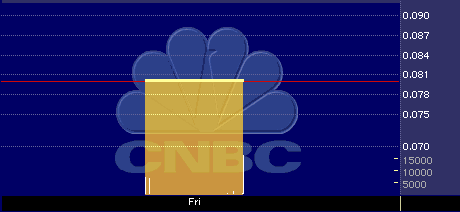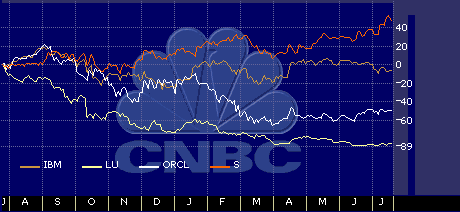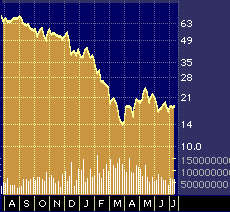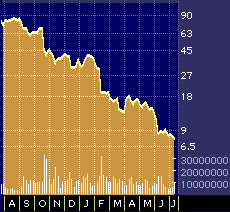
Quintus Corp. IPO Makes Strong Debut
Quintus Corp. IPO Makes Strong Debut
by Hal Plotkin
Silicon Valley Correspondent
Quintus Corp. {QNTS} gives investors a chance to bet on a company that combines preexisting call-center tools with the automated e-mail and Web-based customer-interaction technologies that helped propel Kana Communications Inc. {KANA} and Silknet Software Inc. {SILK} to very successful recent market debuts.
“Silknet and Kana have had phenomenal growth lately,” says David Cooperstein, research director at Forrester Research based in Framingham, Mass.
Who Is Next After Kana and eGain?
Quintus’s 4.5 million share offering priced late Monday at $18 a share, above its stated range of $15 to $17, which was raised from an original range of $12 to $14. The stock opened strongly on Tuesday at 43 1/2.

Quintus Intraday Stock Chart
So what about the prospects for Fremont, Calif.-based Quintus? “I’m cautiously optimistic,” Cooperstein says. “It seems like they’re doing all the right things.”
One reason for the optimism: All three firms are leading players in a market that Forrester says is the second fastest growing segment in the packaged software applications industry.
Forrester says it expects sales of “customer interaction center” software, the core product offered by Kana, Silknet, and now Quintus, to grow at an annual compounded rate of 23.4 percent over the next few years, topping $2.9 billion by 2003, up from $1.04 billion in 1998. The only other packaged-software category that’s growing faster is product-development applications.
Manchester, N.H.-based Silknet was the first of the three firms to go public, pricing its shares at $15 on May 5. The stock topped $100 a share earlier this month and is now bobbing around in the $90 range.

SILK Six-Month Chart
On Oct. 14, Silknet reported record fiscal first-quarter results, with revenue hitting $6.02 million, an increase of 166 percent over the same period last year. The loss for the quarter was $2.8 million, compared with a loss of $2.2 million for the fiscal first quarter last year.
Kana, based in Palo Alto, Calif., was the next automated e-mail responder to go public, on Sept. 21, with shares also initially priced at $15. Mirroring Silknet’s performance, Kana’s stock also quickly skyrocketed, topping out just under $100 before exploding to the $130 range more recently.

KANA Three-Month Chart
Last month, on Oct. 27, Kana also announced a record sales quarter, with revenue jumping 525 percent to nearly $3.6 million, compared with $575,000 during the same quarter last year. The company posted a loss of $5.4 million during the most-recent quarter, as compared with a loss of $1.8 million for the same quarter a year earlier, excluding acquisition-related charges and the amortization of deferred stock compensation.
The strong sales growth at both companies and their rapidly increasing stock prices, are tied to the ever-growing avalanche of e-mail now inundating corporate Web sites. It’s a problem that Quintus, which previously focused on call-center technology, also hopes to turn into an opportunity.
“This is a critical category of software because it solves one of the thorniest problems on the Internet – Web-site abandonment,” wrote Albert Pang, research manager for San Jose, Calif.-based International Data Corp., in a recent report.
It costs U.S. companies, on average, about $2.75 to manually answer e-mail, as compared with about 25 cents with the help of an automated e-mail response system, according to Forrester Research. More than 4 billion e-mails are sent each day, according to a recent estimate by Jupiter Communications, based in New York.
The technology sold by all three firms relies on artificial intelligence algorithms to analyze incoming e-mail and draft appropriate responses which can be sent automatically or forwarded to company personnel for final review prior to transmission. Similar capabilities are also available to facilitate real-time online interactions with customers visiting corporate or e-commerce Web sites.
The more-advanced systems automatically route e-mail to the most appropriate recipient within a company, in addition to giving customer service personnel access to individual e-mail trails whenever a customer calls in for assistance.
“The routing capability is one of the real advantages,” Cooperstein says. “One of the ways you make sure customers get the right answers is to make sure the questions go to the right person.”
Providing customers with that capability has long been one of Quintus’s strong suits. The company has a long list of blue-chip customers, including IBM {IBM}, Lucent Technologies Inc. {LU}, Oracle Corp. {ORCL}, Sears Roebuck & Co. {S}, and the Hilton Hotel and Resort chain, who’ve been using, or reselling, Quintus’ pre-existing call center products. Quintus executives say the move toward providing similar services online is a natural step for their company.

52-Week Comparison Chart: IBM, LU, ORCL, S
“We’re in the customer relationship-building business,” says Lawrence Byrd, Quintus’s vice president of marketing, in an interview granted prior to his company’s filing for an IPO. “Our plan is to give our customers the same excellent services online, through e-mail, and on the Web. If we can help them interact with their customers quickly and more efficiently, that means increased savings and increased sales.”
In September, Quintus announced an agreement to acquire Austin, Texas-based Acuity Corp., a provider of Web-based customer interaction software. “We believe our acquisition of Acuity will further help us offer advanced contact center solutions to companies worldwide,” says John Burke, Quintus’s president, at the time the acquisition was announced.
There’s at least one possible problem facing the company, aside from the dogfight it must wage for customers. Some are concerned that Quintus’s leading call-center customers, Lucent Technologies in particular, might turn into competitors once Quintus moves past its call-center market toward its online field of dreams.
Lucent accounted for nearly 34 percent of Quintus’s revenue during the most recent quarter. Quintus’s distribution agreement with Lucent extends to May 2000 but can be canceled on 30 days notice, under certain circumstances.
“Eventually, Quintus may be forced to either sell out or join forces,” Cooperstein says. “There’s enough business to go around, but over time there’s going to be a lot of consolidation.”
Cooperstein adds that, over the long term, customers are probably going to want to go to just one of two places to purchase customer interaction software and services: switching companies, such as Cisco Systems Inc. {CSCO} and Nortel Networks Corp. {NT}, or application vendors such as Oracle and Siebel Systems Inc. {SEBL}.

CSCO 52-Week Chart

NT 52-Week Chart
“Quintus is going to have to align itself with one of those two camps,” Cooperstein says. “Their IPO is a migration path, not the end of the story. Going public is mandatory if they want to be an acquirer of other companies. On the other hand, if they have a bad quarter or two, they may turn out to be an acquiree.”
Quintus reported a loss of $690,000 on revenue of $10.2 million for the quarter ended June 30, as compared with a loss of $2.7 million on revenue of $7.5 million for the same period one year earlier.


